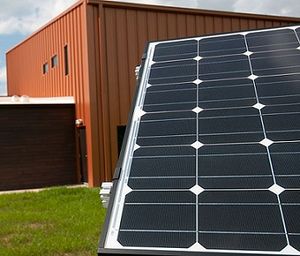Solar panel

A solar panel, or solar module, is one component of a photovoltaic system. They are constructed out of a series of photovoltaic cells arranged into a panel. They come in a variety of rectangular shapes and are installed in combination to generate electricity.[2] Solar panels, sometimes also called photovoltaics collect energy from the Sun in the form of sunlight and convert it into electricity that can be used to power homes or businesses. These panels can be used to supplement a building's electricity or provide power at remote locations.
In addition to residential and commercial use, there is large-scale industrial or utility use of solar. In this case, thousands or even millions of solar panels are arranged into a vast solar array, or solar farm, which provides electricity to large urban populations.
What are Solar Panels Made of?
The main component of any solar panel is a solar cell. Specifically, a number of solar cells are used to build a single solar panel. These cells are the part of the device that convert the sunlight into electricity. Most solar panels are made from crystalline silicon type solar cells.[2] These cells are composed of layers of silicon, phosphorous, and boron (although there are several different types of photovoltaic cells).[3] These cells, once produced, are laid out into a grid pattern. The number of these cells used depends largely on the size of the panel being created, as many different sizing options exist.[2]
Once the cells are laid out, the panel itself is sealed to protect the cells within and covered with a non-reflective glass. This glass protects the solar cells from damage, and is non-reflective to ensure sunlight can still reach the cells.[2] Once sealed, this panel is placed into a rigid metallic frame. This frame is designed to prevent deformation, and includes a drainage hole to prevent water from building up on the panel as a buildup of water could reduce the efficiency of the panel. Additionally, the back of the panel is also sealed to prevent damage.[2]
How Solar Panels Work
Solar panels act as a way to mount a series of solar cells so that their unique properties can be used to generate electricity. Individual cells absorb photons from the Sun, which results in the production of an electric current in the cell through a phenomenon known as the photovoltaic effect.[3] An inverter is used to convert the direct current generated by a solar panel into alternating current. Combined, these two technologies create a photovoltaic system.[3] When installing a solar panel, the proper orientation is chosen so that the solar panel faces in a direction that is most suitable for the specific application. This is most often to produce the maximum annual energy, but is not always the case.
For Further Reading
For further information please see the related pages below:
- Solar power
- Energy flow in ecosystems
- Solar panel orientation
- Solar thermal power plant
- or explore a random page!
References
- ↑ "20110504-RD-LSC-0621 - Flickr - USDAgov" by U.S. Department of Agriculture. Licensed under CC BY 2.0 via Wikimedia Commons - http://commons.wikimedia.org/wiki/File:20110504-RD-LSC-0621_-_Flickr_-_USDAgov.jpg#/media/File:20110504-RD-LSC-0621_-_Flickr_-_USDAgov.jpg
- ↑ 2.0 2.1 2.2 2.3 2.4 Solar Facts and Advice. (August 21, 2015). What is a Solar Panel? [Online]. Available: http://www.solar-facts-and-advice.com/what-are-solar-panels.html
- ↑ 3.0 3.1 3.2 Mr.Solar. (August 21, 2015). What is a Solar Panel? [Online]. Available: http://www.mrsolar.com/what-is-a-solar-panel/

